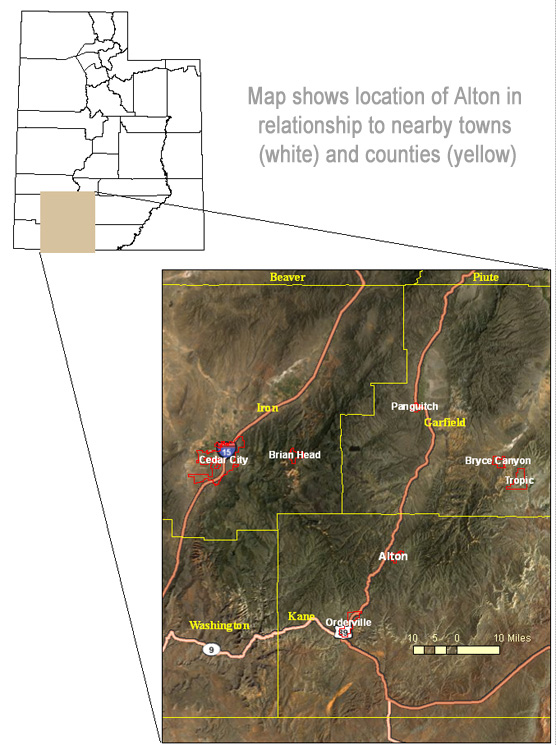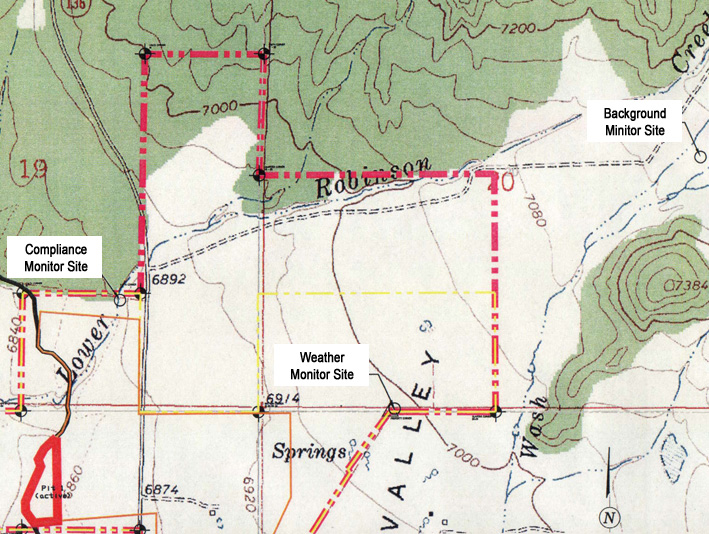The Alton Development Company Coal Mine (Alton Coal) operates a coal mine 30 miles south of Panguitch, Utah, 12 miles southwest of Bryce Canyon National Park, and 25 miles northeast Zion National Park.

Coal Hollow Underground Facilities
In November 2014, Alton Coal proposed changes to its existing permit for the Coal Hollow Mine. The company plans to locate underground facilities within an existing pit area at the mine. The addition of underground facilities would reduce surface disturbance of the permitted area and the length of the haul roads needed to transport coal to the processing/load-out facilities. The company’s Notice of Intent (14 MB) (NOI) proposes the addition of two generators to the current permit to operate underground equipment, including a fan. The generators will create minor increases in all criteria pollutants from the facility.
Coal Hollow Surface Mine
In 2010, Alton Coal submitted a proposal to expand its mine onto leased federal land. The Bureau of Land Management developed and reviewed a draft Environmental Impact Statement on the proposal. The Division of Air Quality (DAQ) issued an Intent to Approve (ITA) and requested public comments on the proposal. Following the public process, all submitted comments were reviewed by DAQ and considered during the final drafting of the permit. The division approved the air quality permit for this project on November 10, 2010, and attached conditions for ongoing air monitoring to ensure compliance with the National Ambient Air Quality Standards (NAAQS) and track the long-term impacts of emissions from the facility.
For questions or more information contact Jon Black (jlblack@utah.gov) at (385) 306-6511.
Applicable Regulations
- 40 CFR 60 Subparts A, Y, IIII and 40 CFR 63 Subpart ZZZZ
- UACR 307-401
Air Monitoring Reports
Alton has completed the purchase of its air monitors and has placed them as specified.
Expand the menu to download individual reports.
Water Quality Public Notices
Expand the menu to see Public Notice archives
Public Notices
2022 Alton Coal Development, LLC – Coal Hollow Project
- Public Notice
- Draft Modified Permit
- Draft Fact Sheet Statement of Basis
- Close of Comments: June 22, 2022
- Public Hearing: None
- Contact (Email): Jeff Studenka (wqcomments@utah.gov)
- Type: UPDES Discharge Permits
2021 Alton Coal Development, LLC – Coal Hollow Project
- Alton Coal Public Notice
- Alton Coal Draft Permit
- Alton Coal Draft FSSOB
- Alton Coal Wasteload Allocation
- Close of Comments: June 25, 2021
- Public Hearing: None
- Contact (Email): Lonnie Shull (lshull@utah.gov)
- Type: UPDES Discharge Permits
2020 Alton Coal Development, LLC – North Private Lease
- Public Notice
- Newspaper Letter
- Signed Agreements
- Close of Comments: May 26, 2020
- Public Hearing: None
- Contact (Email): Jeff Studenka (jstudenka@utah.gov)
- Type: UPDES Discharge Permits
2017 Alton Coal Development, LLC – North Private Lease
- Public Notice
- Close of Comments: August 21, 2017
- Public Hearing: None
- Contact (Email): Bill Damery (wdamery@utah.gov)
- Type: 401 Water Quality Certification
2016 Alton Coal Development, LLC UT0025992
- Public Notice
- Fact Sheet Statement of Basis
- Wasteload Analysis
- Antidegradation Review
- Lab Results
- Reasonable Potential (RP) Analysis
- Draft Permit
- Close of Comments: July 25, 2016
- Public Hearing: None
- Contact (Email): Mike Herkimer (mherkimer@utah.gov)
- Type: UPDES Discharge Permits
2013 Alton Coal Development, LLC—Coal Hollow Project Draft Permit
- Public Notice
- Transmittal to Alton Coal
- Publication Request-Sun
- Publication Request-Spectrum
- Statement of Basis
- Wasteload Analysis
- DMR Data
- Draft Permit
- Close of Comments: July 22, 2013
- Public Hearing: None
- Contact (Email): Mike Herkimer (mherkimer@utah.gov)
- Type: UPDES Discharge Permits

Concern for National Park Visibility
DEQ recognizes that the close proximity of Alton Coal mine to some of Utah’s premier National and State Parks raises questions about visibility and air quality. DEQ is committed to assuring that the permit will protect these values while respecting the rules and regulations that define this process.
For more information on our work on National Park Visibility, see our Regional Haze State Implementation Plan.
DAQ’s Role
The Division of Air Quality (DAQ) is charged with issuing an Approval Order (AO) to Alton Coal Mine if operational plans for the mine meet all state and federal air quality regulations. While groups and individuals may have questions and concerns about this operation, the Division of Air Quality may only act within the confines of the regulatory framework in approving or denying an AO. The review of the AO has been rigorous and complete.
An engineering review showed the largest, actual emissions from the mine will be from PM10 and will be approximately 75 tons per year. While this may sound like a large quantity of particulate, the air dispersion modeling shows that the air will, in fact, meet the National Ambient Air Quality Standards at the property boundary. Additionally, the proposed permit will require the operator to control all sources of particulate emissions through wet suppression methods.
Alton is conducting additional air monitoring for particulate matter at the site. This is above what is required by law. Compliance inspections will be conducted to ensure the air quality standards are being met on a continuous basis.
In addition to PM 10, the mine operation will emit nitrogen oxide (NOx) and sulphur dioxide (SO2). To address these pollutants, the permit will require the use of Selective Catalytic Reduction on the two stationary engines that will be used at the mine. With this reduction, the mine will be considered a minor source of NOx. The permit will limit the emission of SO2 by requiring the use of low-sulfur fuel in the stationary engines, which should significantly lower these emissions.
Determining Compliance
DAQ inspectors will periodically make unannounced visits to the Alton Coal site. In addition, Alton will be required to file regular reports with DAQ.
The air monitoring and quality assurance procedures Alton Coal is required to perform are based on guidelines detailed in Federal Regulations. On a quarterly basis, Alton is to report results to DAQ. The guidelines to be followed are very specific and very familiar to the DAQ scientists who will be reviewing each report to assure compliance. This review will also evaluate:
- the monitored PM10 emissions to make sure the National Ambient Air Quality Standards (NAAQS) are not exceeded;
- for completeness, to ensure the monitoring network is operating at all times and is collecting valid data. For any period of time for which information is missing, Alton must justify why the monitoring network was not operating (machine calibration, power outage, etc.).
- The monitor calibration data to make sure the data received and reviewed has been accurately measured.
If discrepancies are found, the company will be sent a compliance action to resolve the issue. Warning letters are typically sent when DAQ documents minor instances of non compliance that the company has already returned to compliance or can immediately return to compliance. An example may be a report was submitted a day or two late or a monitor was not calibrated on time.
More severe discrepancies are handled through a compliance action notice. Any compliance action notice would also require the company to immediately return to compliance and may require the company to pay a penalty in addition to fixing the problem. An example would be failing to submit a report or if DAQ is unable to determine compliance due to missing data or uncalibrated equipment. Penalties can range from $300 – $10,000 per day per violation.

